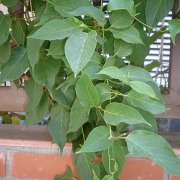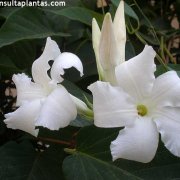Care of the climbing plant Mandevilla laxa or Chilean Jasmine |
|
The genus Mandevilla, family Apocinaceae, comprises 100 species of climbing plants native to Central and South America. Some species are: Mandevilla laxa, Mandevilla sanderi, Mandevilla boliviensis, Mandevilla scabra, Mandevilla splendens. Common name: Chilean Jasmine. This species is native to southern Ecuador, Peru, Bolivia, and northern Argentina. They are semi-perennial climbing shrubs that reach 5 meters (16.4 feet). The leaves are ovate, 10 cm (3.93") long, and appear in opposite pairs. The scented flowers are tubular, have 5 petals and are white, pink or red. They bloom in early summer. Chilean Jasmine is used to cover walls, fences and pergolas (it needs supports) and as indoor or greenhouse plants in large pots. Mandevilla laxa can grow in full sun or semi-shade exposure. It's a tropical plant that does not resist temperatures below 10 ºC (50 ºF). The soil can be a commercial indoor plant substrate with 15% coarse sand. In case of transplantation, it is done in spring or autumn. Water regularly from spring to autumn at the rate of 2 liters per plant 2 times a week. In winter reduce watering. Prune intensively just after flowering to strengthen the plant. Fertilize every 15 days in summer with nitrogen-rich fertilizer and once with manure in autumn. Mandevilla laxa is a quite resistant plant to the usual pests and diseases. Chilean Jasmine propagates by seeds sown in spring or by cuttings in summer. |
Images of the climbing plant Mandevilla laxa or Chilean Jasmine |
Find plants
Mandevilla laxa or Chilean Jasmine | Care and Growing
© 2025 FavThemes


